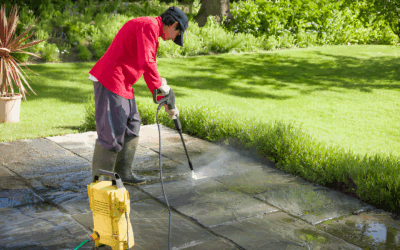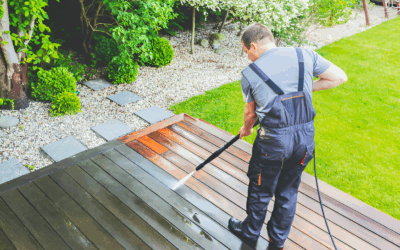Introduction
Vinyl siding is a popular choice for homeowners due to its durability and low maintenance. However, over time, dirt, mold, and mildew can build up, making your home look less appealing. The good news? You don’t have to spend hours scrubbing to restore your siding’s beauty. In this guide, we’ll explore the best ways to clean vinyl siding without scrubbing, including professional techniques like soft washing and easy DIY solutions.
Why is Cleaning Vinyl Siding Important?
Protects Your Home’s Curb Appeal
Your home’s exterior is the first thing people notice. Stained, dirty, or moldy siding can make a home look neglected and uninviting. Regular cleaning keeps your home looking fresh, improving curb appeal and potentially increasing its value.
Prevents Mold and Mildew Growth
Moisture can lead to mold and mildew, which not only looks unsightly but can also pose health risks. Mold spores can cause respiratory issues, allergies, and other health problems, making it crucial to keep siding clean and free from mold buildup.
Extends the Life of Your Siding
Dirt, grime, and mold can slowly degrade vinyl siding, leading to cracks, discoloration, and even structural damage over time. Regular maintenance helps prevent these issues, ensuring your siding lasts longer and saving you money on costly replacements.
Best Way to Clean Vinyl Siding Without Scrubbing
Soft Washing: The Gentle Yet Effective Solution
Soft washing is a low-pressure cleaning method that uses a specialized cleaning solution to break down dirt, mold, and algae. Unlike pressure washing, which can be too harsh on vinyl siding, soft washing ensures your siding remains undamaged while achieving a deep clean.
Benefits of Soft Washing
- No Scrubbing Required: The cleaning solution does all the work by breaking down grime and mold.
- Safe for Your Siding: Unlike high-pressure washing, soft washing won’t cause cracks, warping, or water intrusion.
- Long-Lasting Results: The cleaning agents not only remove dirt but also help prevent mold and mildew regrowth, keeping your siding cleaner for longer.
For expert soft washing services, check out Hampton Roads Power Washing.
DIY Cleaner for Vinyl Siding
If you prefer a hands-on approach, you can create an effective DIY cleaner using common household ingredients. This method is budget-friendly and environmentally safe.
DIY Vinyl Siding Cleaning Solution
Ingredients:
- 1 gallon of water
- 1 cup of white vinegar (effective for mold and mildew)
- 1/2 cup of dish soap (helps break down dirt and grease)
- Optional: 1/2 cup of bleach for stubborn stains (use sparingly to avoid discoloration)
Instructions:
- Mix the ingredients in a large bucket.
- Transfer the solution to a garden sprayer for easy application.
- Spray the solution onto the siding and let it sit for 10-15 minutes to break down grime.
- Rinse off with a garden hose, starting from the top and working your way down.
Using a Spray-On Siding Cleaner
Spray-on siding cleaners are designed for convenience. These pre-mixed solutions make cleaning vinyl siding even easier by eliminating the need for scrubbing.
How to Use Spray-On Cleaners
- Choose a cleaner specifically designed for vinyl siding.
- Attach the bottle to a garden hose (if applicable) and spray evenly over the siding.
- Allow the solution to break down dirt and grime for the recommended time.
- Rinse thoroughly with water, ensuring no residue is left behind.
Can You Use Bleach on Vinyl Siding?
Yes, but with caution! Bleach is effective for removing mold and mildew but should always be diluted to prevent damage or discoloration.
How to Safely Use Bleach
- Mix one part bleach with four parts water.
- Apply using a spray bottle or garden sprayer.
- Let it sit for 5-10 minutes before rinsing with water.
- Avoid prolonged exposure to prevent discoloration and weakening of the siding.
- Never mix bleach with ammonia or other cleaners, as it can produce toxic fumes.
Professional House Washing Services
If DIY cleaning isn’t your thing, hiring a professional house washing company is the best way to ensure thorough and safe cleaning.
Benefits of Professional House Washing
- Expertise: Professionals know how to clean different types of siding without causing damage.
- Time-Saving: No need to spend your weekend scrubbing or spraying.
- Better Results: High-quality equipment ensures a deeper clean with longer-lasting effects.
Find trusted house washing companies near me at Hampton Roads Power Washing.

Conclusion
Cleaning your vinyl siding doesn’t have to be a labor-intensive task. By using soft washing, DIY solutions, or professional house washing services, you can keep your home looking pristine without scrubbing.
For a hassle-free and effective cleaning solution, consider hiring a house washing company like Hampton Roads Power Washing to get the job done right.
By following these tips, you’ll enjoy a cleaner, well-maintained home year-round, preventing damage and ensuring your siding stays in great condition for years to come!
Frequently Asked Questions
Q2: Can I use a pressure washer on vinyl siding?
A: While pressure washing can be effective, too much pressure can damage the siding. Soft washing is a safer alternative.
Q3: How often should I clean my vinyl siding?
A: It’s recommended to clean your siding at least once a year to prevent buildup and prolong its lifespan.
Q4: What should I use to wash vinyl siding?
A: A soft washing solution, DIY vinegar-based cleaner, or commercial spray-on cleaner works best.
Q5: Are professional house pressure washing services worth it?
A: Yes! Professionals have the right tools and expertise to ensure a thorough, damage-free clean.
Q6: What is the best time of year to clean vinyl siding?
A: Spring and fall are the best times to clean siding, as moderate temperatures help cleaning solutions work effectively without drying too fast.
Q7: Will soft washing prevent mold and mildew from coming back?
A: Yes! Soft washing solutions contain mold inhibitors that help prevent regrowth, keeping your siding cleaner for longer.
Q8: How do I keep my vinyl siding clean longer?
A: Regular maintenance, annual cleanings, and trimming back trees or bushes to reduce moisture exposure can help prevent buildup.



